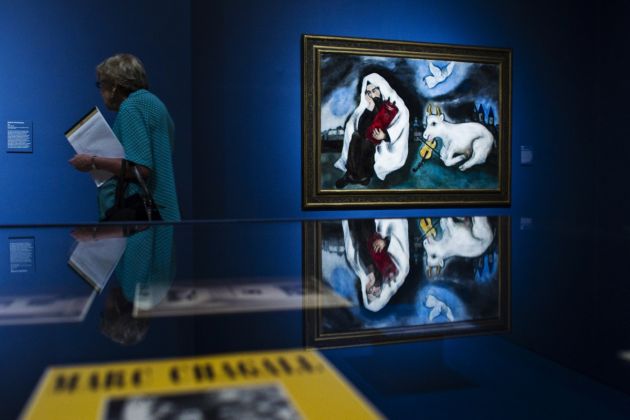New York exhibit explores Chagall's art during war years, exile

NEW YORK (Reuters) - An exhibit of paintings by the artist Marc Chagall explores a neglected period in Chagall's career in Paris during the rise of fascism in the 1930s and while he was in exile in New York during the 1940s.
"Chagall: Love, War and Exile," which runs through Feb. 2 at the Jewish Museum, includes 31 paintings and 22 works on paper, and selected letters, poems and photographs.
The works in the exhibit, divided into four galleries, show how Chagall used the image of Christ on the cross to depict the suffering of Jews.
"Chagall approached this subject in a very personal way. In certain works the image of the Jewish Jesus conveyed his personal angst while in others he equated the martyrdom of Jesus on the cross with the persecution of the Jewish people," said Susan Tumarkin Goodman, the curator of the exhibit.
The artist, who was born in 1887 in Vitebsk in Belarus to a religious family, created a simple line drawing of the Crucifixion as early as 1908, but it did not become a prevalent image in his work for another three decades.
After the Russian Revolution, Chagall moved to Paris with his wife and daughter. Goodman said living away from his homeland inspired work based on memories of his childhood.
Chagall drew on symbols meaningful to both Jews and Christians. A 1933 painting, "Solitude," shows a Jew wrapped in a prayer shawl, holding a Torah scroll as an angel flies skyward.
"'Solitude' was done in direct response to Hitler's election as chancellor of Germany and the onset of the Nazi regime," said Goodman. "It's a very melancholy picture, a foreshadowing of things to come."
SENSE OF DISPLACEMENT
In June 1941 Chagall and his wife, together with many other Jewish refugees, escaped the war in Europe, sailing from Lisbon to New York at the invitation of Alfred Barr of the Museum of Modern Art.
Chagall's paintings, however, were held up in transit. His daughter, Ida, and her husband booked passage on a freighter that carried more than 700 refugees to New York. Chagall's art was loaded on the ship and closely guarded by Ida.
The war, and his exile in New York, left Chagall with a profound sense of displacement, Goodman said. Themes of violence and disruption re-emerged in his work.
In "The Crucified," a 1944 painting, Chagall memorializes his hometown after it was razed in a three-day battle between the Germans, who had occupied it since 1941, and the advancing Russian army.
"'Ich bin Jude' is written on a sign on the chest of a crucified East European Jew, a laborer," Goodman said. "'The Crucified' is a work about Jewish slaughter."
In the same picture, a man sits on a rooftop, gazing at the crucified figures and the people, including a mother clutching her child, lying murdered on the street.
"Chagall was in America, feeling isolated and helpless. The man he painted on the roof is the sole witness to an entirely dead village," Goodman said.
In 1943, after the destruction of the Warsaw ghetto, Chagall painted "Obsession," depicting Jesus on a toppled cross as a shtetl, or small Jewish village, burns around him.
In "Apocalypse in Lilac (Capriccio)," done a few years later, Chagall underscores the metaphor of Jewish suffering, painting a swastika on the arm of the figure at the foot of the cross.
"'Apocalypse in Lilac' was created after the revelations about the death camps and crematoria and based on details revealed in photographs after World War Two," Goodman said.
"The Boat Exodus" also drew on a real event in 1947 when the ship Exodus, filled with Holocaust survivors bound for Palestine, was turned backed to Europe by British authorities.
Chagall's feeling of isolation in New York intensified with the sudden death of his beloved wife, Bella, in September 1944.
After he developed a new relationship with Virginia Haggard McNeil, his work showed a tension as he came to terms with the memory of his wife and his new life.
As Chagall emerged from his sadness and the horrors of war receded, his work evoked more of the joy that had characterized his pre-war works.
A catalog, "Chagall: Love, War, and Exile," accompanies the exhibit.
(Reporting By Ellen Freilich; editing by Patricia Reaney and Kenneth Barry)